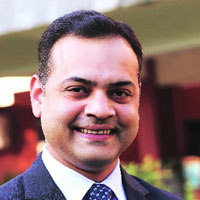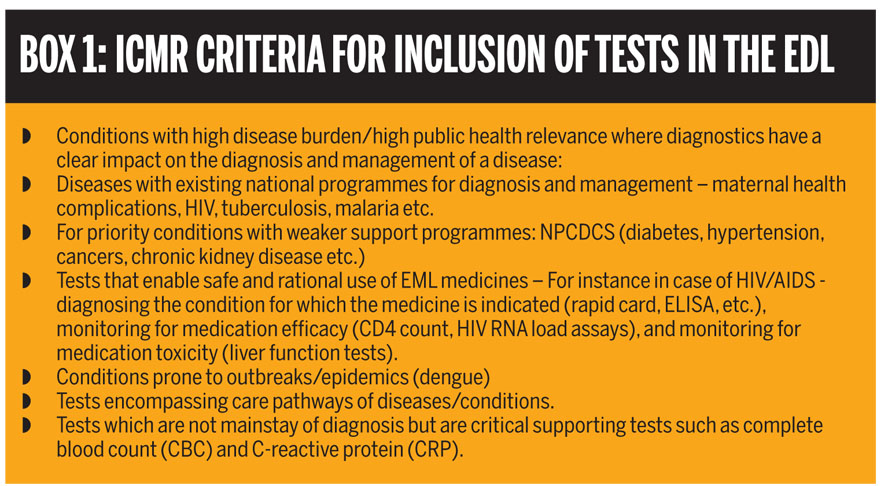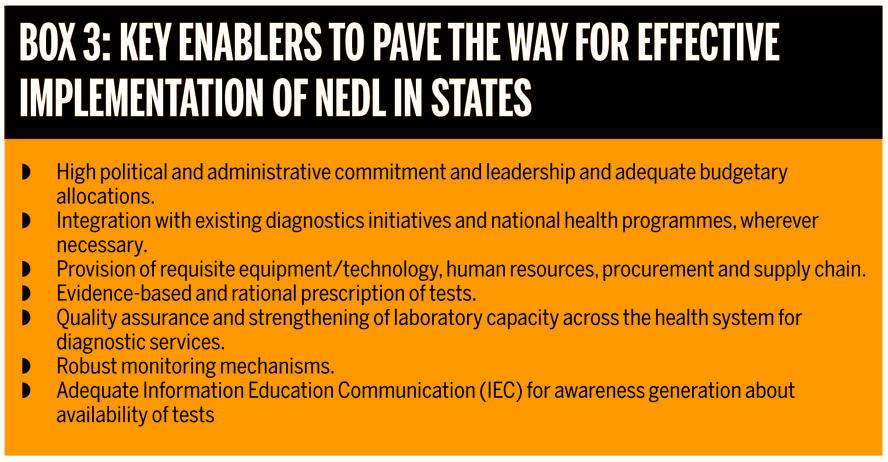The National Essential Diagnostics List (NEDL) is a much-needed step towards standardisation of diagnostics in India. However, its true success will depend on its rational implementation, focus on quality, partnerships with private sector and the right investment in human resource,
and supply chain
By Raelene Kambli
Access to quality diagnostics is a key component to universal health coverage (UHC). While India has been focussing on increasing access to healthcare services across the country, many villages and rural lands still remain deprived of basic health and diagnostics needs. Disease management for a long time has largely relied on empirical therapies and syndromic management. And this clearly reflects the lack of access to quality diagnostics services.
A study conducted by The Lancet, in its October 2018 issue, titled Availability of Essential Diagnostics in Primary Care in India indicated major gaps in availability of essential tests. The study examined three districts in three states of India, in north, south, central zones: Tumkur, Karnataka, 13 in Fatehpur, Uttar Pradesh, six in Wardha, Maharashtra, between December 13, 2017 to March 22, 2018. The study found gaps that can limit the ability of health workers to manage common diseases and the ability of the health systems to respond to threats such as outbreaks or antimicrobial resistance. This poses a huge challenge to tackle problems such as antimicrobial resistance, epidemics and non-communicable diseases (NCD).
Nevertheless in July this year, India took the unprecedented step of releasing its first National Essential Diagnostics List (NEDL) based on the WHO essential in vitro diagnostics (IVD) list (EDL). The NEDL has been compiled by the ICMR with a vision to ensure availability of good quality and affordable diagnostics services across India.
Key factors of the NEDL
According to ICMR, the process of compiling the NEDL was accomplished through a series of consultation meetings with the first meeting being organised in March 2018. Consultations with relevant stakeholders such as national programme managers, microbiologists, pathologists, clinicians, health administrators and NGO/association representatives were organised subsequently to arrive at a list that is realistic and yet progressive.
Based on expert suggestions, the NEDL provides a minimum set of tests that should be made available for patients. The NEDL focusses on 105 general laboratory tests, listed for detection and diagnosis of a broad range of common conditions and 30 disease specific tests designed for diagnosis and monitoring of diseases such as HIV, hepatitis A, B, C, D and E, tuberculosis, dengue, malaria and diseases of endemic areas like scrub typhus, Japanese encephalitis, filariasis etc. The list also encompasses 24 radiology tests such as X-Ray, MRI, USG etc. The list enumerates tests which should be available at – village level, sub-centre/Heath and Wellness Centres (HWs), Primary Health Centres (PHC)/HWs, Community Health Centres (CHC), Sub-District Hospital (SDH), and District Hospital (DH). In the absence of availability of lab infrastructure or resources and to minimise the patient movement between providers, a ‘hub and spoke model’ has been suggested. This will ensure availability of the required number of tests at different levels of facilities in a cost-efficient way. The list also encompasses tests relevant for new programmes such as Health and Wellness Centres (HWCs) under Pradhan Mantri Jan Arogya Yojana. In addition to tests, corresponding IVD products have also been recommended, as per ICMR sources.
Moreover, ICMR sources informed that the list also builds upon the Free Diagnostics Service Initiative which is crucial for the implementation of this plan. As experts point out that the impact of NEDL depends on the access to the diagnostic facilities enlisted. Hence, it is a must to integrate it with the revised Indian Public Health Standards (IPHS), the Health and Wellness Centres as well as the central government’s free diagnostic service and universal health coverage initiatives under the Ayushman Bharat umbrella. Such an integration would not only be crucial for ensuring access, but would also go a long way in making the services affordable for all classes of society and in all parts of the country. For this reason, ICMR also suggests the human resource and equipment requirement proposed under the revised Indian Public Health Standards (IPHS). (Checkout the criteria for inclusion of test and key principals outlining the scope of the NEDL. Box 1 and 2). Also, the ICMR has drawn out specific enablers that can be beneficial for the successful implementation of NEDL. (Read on: Key enablers to pay the way for effective implementation. Box 3)
An opportunity or setback
According to ICMR, NEDL provides a perfect opportunity for healthcare providers and the government to expand existing diagnostics services. ICMR also informs that NEDL will be instrumental just as the Essential Medicine List (EML) to bring in price control in diagnostics. Now, the industry seems to have mixed emotions with regard to this stance. While most players believe that the NEDL can standardise access to quality diagnostics in the country, yet its ramifications and lasting impact cannot be judged at the moment.
Just as ICMR suggests, Dr Sushil Shah, MD, Metropolis Healthcare, foresees opportunities to expand services and partner with the government. He says, “India has become the first country in the world to compile an Essential Diagnostics List that will help the government to facilitate diagnostic needs in the remotest part of the country. A lot of inputs have come from the first edition of essential diagnostics list released by WHO last year. The list released by ICMR is customised to the needs of the country and its population as well. This is set to be beneficial to large established players like Metropolis as we have the strength to deliver in any corner of the country. With effective public private partnerships (PPP) and with government taking the role of a facilitator, it is possible for the highest healthcare quality services to be delivered to every single citizen of this country.”
“NEDL implementation would lead to an improvement in healthcare delivery based on proper diagnosis and better patient outcomes. It would help in making public health facilities more efficient and is also likely to bring down the out-of-pocket expenditure burden which has so far been a major detriment in mass access to quality healthcare. Further, it is expected to result in better detection and calculation of th

e disease burden in the country, the trends, causes and various other aspects related to outbreaks and proliferation of health conditions in India. The move will also help address the critical gap in the standardisation of medical equipment and in-vitro diagnostic devices in India that has been in place due to lack of regulatory guidelines. One of the main aims of the NEDL is to create a guideline for the government to finalise the necessary diagnostic services for rural and far-flung areas in the country. Thus, it will be instrumental in providing access to affordable and quality diagnostic services to people all over the country, even in the remotest areas,” shares Dr Prashant Kumar Dash, Director-Medical Services, Medlife.com.
Likewise, technology and equipment provider, Dr Suresh Vazirani, MD, Transasia Bio-Medicals also sees this an opportunity to reach out to those providers who aim to tap rural markets. He says, “NEDL is a good move to increase access to diagnostics. This also means that it will open new avenues to people trying to venture into rural areas and this will bring us more business too. But its right kind of implementation will be crucial.”
Sharing a contrarian view, Dr Arun Dang, Associate Lab Director, Dr Dangs Lab, indicates that NEDL would in all probability lead to regularisation/capping of certain test costs that can be charged to the patients. This will also improve the much-needed accessibility to diagnostics but can negatively impact quality of services. “Although NEDL is an essential step to achieve universal healthcare, the snow-ball effect of capping diagnostics by the government would have a definite negative effect in terms of quality

of testing and lab reports. On one hand it is essential for a large part of India in tier 2, 3 cities and villages where the affordability of the patient is a prime concern but in metro cities, tests at lower costs would definitely mean substandard equipment, manpower and lower levels of care,” he asserts. He further gives a simple example of a peripheral smear or a stool routine being microscopically examined and reported by a lab technician vs a DM hematopathology/ MD microbiology and said that it would have a huge impact in quality of the report and also the costs involved.
Dr Sanjay Arora, MD, Suburban Diagnostics, adds, “Getting the policy executed at the grass root level will see a hugely positive impact on the health outcomes. An additional aspect that will be important will be the presence of well trained manpower — skilling could be a big challenge but also an opportunity to make this process more inclusive.”
So as experts continue to examine its impact, there are some developments which will be certain after the actual implementation of NEDL.
Standardisation of tests
India’s diagnostics industry has been a very fragmented market for a very long time. The sector lacked standardisation and therefore, timely and reliable diagnosis in many areas still remain a huge concern. Currently, accreditation with the National Accreditation Board for Testing and Calibration Labo

ratories (NABL) under the Quality Council of India (QCI) is optional and not mandatory. This has led to disparity in diagnostic approach adopted by various public health institutions and healthcare providers in different parts of the country. Additionally, lack of standards also gives rise to differential pricing which can considerably impact affordability if done irrationally. Hence, industry people believe that NEDL must focus on standardisation that reduces disputes, increase collaborations and improve health outcomes. “Having a standardised list is always helpful as it creates transparency, awareness and ensures that comparable services are provided to the patients no matter where they go. The government should focus its energies on standardising not only that which is offered but also how it is offered. The government should create mechanisms to check and control quality to a more significant degree than it is done today,” suggests Zoya Brar, CEO, Core Diagnostics.
Rationalisation of prices
While quality is one aspect of standardisation, appropriate pricing is another focal point of this list. NEDL promises to bring rationalisation of pricing which can be beneficial to patients but can shrink profit margins of diagnostics providers and diagnostics kit manufacturers. “Considering that only 1 out of every 5 persons in India has ever opted to give their blood for testing, post implementation of NEDL and capping of tests this percentage is bound to increase. But as the test costs are going to come down significantly, the margins for providers will definitely be slashed,” ascertains Dr Dang.
In the same light, Brar says that there would be an adverse downstream effect for patients and providers both. She says, “NEDL would impact the margins of the pathology labs and diagnostic kit providers. More than margins, the bigger problem is that it will affect the consumer in the long run in a negative way. The companies will find ways to keep their margins intact by working around the quality parameters and it would be the customer at the end who bears the brunt of it.”
Having said that, Dr Arora and Dr Dash believe that at present the ICMR is only focussing on standardisation in terms of quality and price control may not be the current goal. “I don’t see it making any adverse impact on the margins of pathology labs or diagnostic kits/devices providers. Yes, there would be standardisation which in certain cases might curtail margins for those charging haphazardly for diagnostic services. At the same time, by clearly outlining the processes to follow, it would also ensure that pathology labs, diagnostic services providers get to play a more active and inclusive role in providing quality healthcare to the public. Hence, I see it as an initiative which will make a positive impact on the public as well as the providers,” feels Dr Dash.

Explaining further, Dr Arora spells out, “At this point, the purpose appears more of playing a regulatory role rather than one of price control. Standardisation of services is very important. This should allow only those service providers to operate that confirm to the basics set forth in the policy. Price control may become an outcome in future provided everyone operates on a level (standardised) playing field. At this time, price or margins should not get affected as the intent is more of standardisation and regulations to bring a basic level of acceptance to service and quality outcomes.”
Well as the impact of NEDL standardisation in terms of price is yet to be established, another area that the industry contemplates is the involvement of the states in its implementation. How important is the role of state governments in adopting NEDL and should the NEDL be implemented in phased manner within the state? This is crucial a question to be answered.
Increased role of state governments
Healthcare has always been a state’s subject in India; therefore, the role of the state governments in its implementation will increase. Most industry people believe that a phase-wise implementation will be a good strategy to adopt. This can also help the states and the central government rectify mistakes.
“Since this is a massive task being done for the first time, working towards optimum implementation and monitoring will be critical. Addressing the top of the tier which manages the largest population base and then working down the pyramid will allow both time and development of operational bandwidth, necessary for successful implementation,” says Dr Arora.
Getting the buy-in of local governments and local administration will be very important for the seamless and effective adoption of NEDL. The government can put a policy in place but ensuring that it is implemented along with the necessary infrastructure and systems, takes time and effort. State-level authorities are required to ensure that NEDL is efficiently regulated and widely available. A colossal initiative, such as NEDL, would require regulation and coordination at both national and state-level,” adds Brar.
Good governance and investment need
Furthermore, implementation will need to be backed by a strong monitoring system. If there is very little or no evaluation and monitoring done, there is certainty of a huge failure. Therefore, a robust monitoring system is crucial and only then can the NEDL become the standard for benchmarking access. A white paper in Dr Sulaiman Al Habib Medical Journal and written by Dr Madhukar Pai, Prof, McGill International TB Centre, McGill University, Montreal, Canada recently reviewed India’s draft NEDL. The report states that for a successful implementation of the NEDL, India will have to invest in strengthening public laboratories, contract private laboratories as required and make sure quality-assured testing services are freely available at all facilities. To address the weak laboratory capacity, four key barriers must be tackled: insufficient human resources or workforce capacity, inadequate education and training, inadequate infrastructure, insufficient quality, standards, and accreditation. Apart from this, a strong supply chain system will also be crucial. In the future, there is immense scope for NEDL to be a key in streamlining diagnostics supply chain in the country. NEDL also has the potential to be this great source of healthcare data that reflects the nation’s healthcare needs and disease burden.



raelene.kambli@expressindia.com
- Advertisement -


